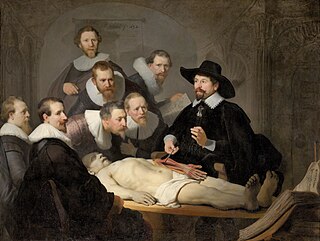
In female human anatomy, Skene's glands or the Skene glands are two glands located towards the lower end of the urethra. The glands are surrounded by tissue that swells with blood during sexual arousal, and secrete a fluid, carried by the Skene's ducts to openings near the urethral meatus, particularly during orgasm.

In human anatomy, the fibularis longus is a superficial muscle in the lateral compartment of the leg. It acts to tilt the sole of the foot away from the midline of the body (eversion) and to extend the foot downward away from the body at the ankle.

A fascia is a generic term for macroscopic membranous bodily structures. Fasciae are classified as superficial, visceral or deep, and further designated according to their anatomical location.

The buccinator is a thin quadrilateral muscle occupying the interval between the maxilla and the mandible at the side of the face. It forms the anterior part of the cheek or the lateral wall of the oral cavity.

The thyroid cartilage is the largest of the nine cartilages that make up the laryngeal skeleton, the cartilage structure in and around the trachea that contains the larynx. It does not completely encircle the larynx.

The iris dilator muscle, is a smooth muscle of the eye, running radially in the iris and therefore fit as a dilator. The pupillary dilator consists of a spokelike arrangement of modified contractile cells called myoepithelial cells. These cells are stimulated by the sympathetic nervous system. When stimulated, the cells contract, widening the pupil and allowing more light to enter the eye.

The anconeus muscle is a small muscle on the posterior aspect of the elbow joint.

In human anatomy, the fibularis tertius is a muscle in the anterior compartment of the leg. It acts to tilt the sole of the foot away from the midline of the body (eversion) and to pull the foot upward toward the body (dorsiflexion).

The ilium is the uppermost and largest region of the coxal bone, and appears in most vertebrates including mammals and birds, but not bony fish. All reptiles have an ilium except snakes, although some snake species have a tiny bone which is considered to be an ilium.
Nomina Anatomica (NA) was the international standard on human anatomic terminology from 1895 until it was replaced by Terminologia Anatomica in 1998.

Terminologia Anatomica is the international standard for human anatomical terminology. It is developed by the Federative International Programme on Anatomical Terminology, a program of the International Federation of Associations of Anatomists (IFAA).
Keith Leon Moore was a professor in the division of anatomy, in the faculty of Surgery, at the University of Toronto, Ontario, Canada. Moore was associate dean for Basic Medical Sciences in the university's faculty of Medicine and was Chair of Anatomy from 1976 to 1984. He was a founding member of the American Association of Clinical Anatomists (AACA) and was President of the AACA between 1989 and 1991.

The International Federation of Associations of Anatomists (IFAA) is an umbrella scientific organization of national and multinational Anatomy Associations, dedicated to anatomy and biomorphological sciences.

The annular ligament is a strong band of fibers that encircles the head of the radius, and retains it in contact with the radial notch of the ulna.

The inferior tibiofibular joint, also known as the distal tibiofibular joint, is formed by the rough, convex surface of the medial side of the distal end of the fibula, and a rough concave surface on the lateral side of the tibia.

The accessory meningeal artery is a branch of the maxillary artery that ascends through the foramen ovale to enter the cranial cavity and supply the dura mater of the floor of the middle cranial fossa and of the trigeminal cave, and to the trigeminal ganglion.
The Terminologia Embryologica (TE) is a standardized list of words used in the description of human embryologic and fetal structures. It was produced by the Federative International Committee on Anatomical Terminology on behalf of the International Federation of Associations of Anatomists and posted on the Internet since 2010. It has been approved by the General Assembly of the IFAA during the seventeenth International Congress of Anatomy in Cape Town.
The Terminologia Histologica (TH) is the controlled vocabulary for use in cytology and histology. In April 2011, Terminologia Histologica was published online by the Federative International Programme on Anatomical Terminologies (FIPAT), the successor of FCAT.
The Pan American Association of Anatomy (PAA) is a public, nonprofit, scientific organization that brings together professionals engaged in the study of Anatomy and related sciences in the American continent.

Anatomical terminology is a specialized system of terms used by anatomists, zoologists, and health professionals, such as doctors, surgeons, and pharmacists, to describe the structures and functions of the body.














